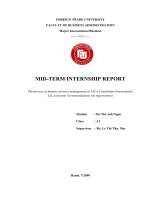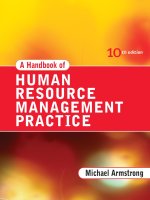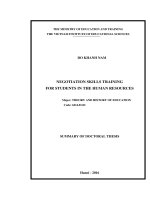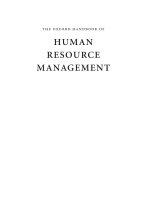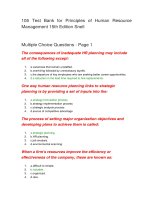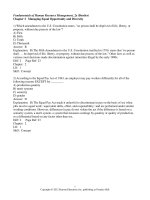Principles of human resource management edition 1
Bạn đang xem bản rút gọn của tài liệu. Xem và tải ngay bản đầy đủ của tài liệu tại đây (129.69 KB, 21 trang )
EDITION 1
PRINCIPLES OF
HUMAN RESOURCE
MANAGEMENT
Scott SnelL
Professor of Business Administration,
University of Virginia
Professor Emeritus of Management,
Arizona State University
SOUTH-WESTERN
CENGAGE LearningAustralia • Brazil 'Japan • Korea • Mexico • Singapore • Spain • United Kingdom • United States
PART
Human Resource Management in Perspective
Chapter 1 The Challenge of Human Resources Management
Why Study Human Resources Management?
4
Competitive Challenges and Human Resources Management
Challenge 1: Competing, Recruiting, and Staffing Globally
Challenge 2: Embracing New Technology
5
5
7
Highlights in HRM 1: A Guide to HR Internet Sites
8
Highlights in HRM 2: Automation of Talent Management Functions
Challenge 3: Managing Change
Challenge 5: Responding to the Market
15
22
22
Highlights in HRM 3: Social Issues in HRM
Cultural Changes
13
17
Demographic and Employee Concerns
Demographic Changes
11
12
Challenge 4: Managing Talent, or Human Capital
Challenge 6: Containing Costs
2
23
28
Highlights in HRM 4: Why Diversity?
30
The Partnership of Line Managers and HR Departments
Responsibilities of the Human Resources Manager
Competencies of the Human Resources Manager
31
32
33
Highlights in HRM 5: SHRM Code of Ethical and Professional
Standards in Human Resource Management 35
Role of the Line Manager
Summary
Key Terms
38
39
40
Discussion Questions
41
HRM Experience: Balancing Competitive Challenges and Employee
Concerns 41
vii
Contents
Case Study 1: A Chip off the Rock: Outsourcing HR at
Prudential 42
Case Study 2: Managing "Daddy Stress" at Baxter
Healthcare 43
Notes and References
45
Chapter 2 Strategy and Human Resources Planning
Strategic Planning and Human Resources
50
Strategic Planning and HR Planning: Linking the Processes
Step One: Mission, Vision, and Values
Step Two: Environmental Analysis
Competitive Environment
48
51
51
53
53
Step Three: Internal Analysis
57
The Three Cs: Culture, Capabilities, and Composition
Forecasting: A Critical Element of Planning
57
61
Highlights in HRM 1: HR Planning and Strategy Questions to Ask
Business Managers 64
Assessing a Firm's Human Capital Readiness: Gap Analysis 67
Highlights in HRM 2: Succession-Planning Checklist
Step Four: Formulating Strategy
Corporate Strategy
Business Strategy
68
70
70
72
Highlights in HRM 3: Key HR Activities Associated with Merger or
Acquisition Phases 73
Functional Strategy: Ensuring Alignment
Step Five: Strategy Implementation
75
76
Taking Action: Reconciling Supply and Demand
77
Step Six: Evaluation and Assessment 79
Evaluation and Assessment Issues 79
Highlights in HRM 4: Ten Measures of Human Capital
Measuring a Firm's Strategic Alignment
81
Ensuring Strategic Flexibility for the Future
Summary
Key Terms
82
84
85
Discussion Questions
85
HRM Experience: Customizing HR for Different Types of
Human Capital 86
80
Contents
IX
Case Study 1: Misplaced Affections: Discharge for
Sexual Harassment 87
Case Study 2: A "Bad Hair Day" or Religious Custom?
Notes and References
89
90
Appendix: Calculating Turnover and Absenteeism
Employee Turnover Rates
93
93
Computing the Turnover Rate
93
Determining the Costs of Turnover
Employee Absenteeism Rates
94
94
Computing Absenteeism Rates
94
Highlights in HRM 5: Costs Associated with the Turnover
of One Computer Programmer 95
Comparing Absenteeism Data
Costs of Absenteeism
96
96
Absenteeism and HR Planning
Notes and References
PART
96
97
Meeting Human Resources Requirements
Chapter 3 Equal Employment Opportunity and Human Resources
Management 98
Historical Perspective of EEO Legislation
Changing National Values
Economic Disparity
101
101
102
Early Legal Developments
102
Government Regulation of Equal Employment
Opportunity 102
Major Federal Laws
103
Highlights in HRM 1: Test Your Knowledge of Equal Employment
Opportunity Law 104
Other Federal Laws and Executive Orders
Fair Employment Practice Laws
114
115
Other Equal Employment Opportunity Issues
Sexual Harassment
116
116
Highlights in HRM 2: Questions Used in Auditing Sexual
Harassment 118
Contents
Highlights in HRM 3: Basic Components of an Effective Sexual
Harassment Policy 119
Sexual Orientation
120
Immigration Reform and Control
120
Uniform Guidelines on Employee Selection Procedures
Enforcing Equal Employment Opportunity Legislation
The Equal Employment Opportunity Commission
Record-Keeping and Posting Requirements
124
124
125
Highlights in HRM 4: 2007 EEO-1 Survey
Processing Discrimination Charges
121
127
128
Highlights in HRM 5: EEOC Poster
129
Highlights in HRM 6: EEOC Guidelines on Retaliation
Preventing Discrimination Charges
131
132
Diversity Management: Affirmative Action 133
Establishing Affirmative Action Programs 133
Highlights in HRM 7: Basic Steps in Developing an Effective
Affirmative Action Program 134
Managing Diversity: Affirmative Action
Summary
Key Terms
135
137
138
Discussion Questions
138
HRM Experience: Sexual Harassment: A Frank Discussion
139
Case Study 1: Building a Stealth Fighter with Virtual Teams
140
Case Study 2: Empty Cubicles: How Would You Manage
the Vacancy? 141
Appendix: Determining Adverse Impact
Notes and References
143
144
Chapter 4 Job Analysis, Employee Involvement, and Flexible
Work Schedules 148
Relationship of Job Requirements and HRM Functions
Recruitment
Selection
150
151
Training and Development
Performance Appraisal
151
151
Compensation Management
151
150
Contents
XI
Job Analysis
152
Job Analysis and Essential Job Functions
Gathering Job Information
152
153
Controlling the Accuracy of Job Information
Approaches to Job Analysis
Job Descriptions
154
155
158
Highlights in HRM 1: Job Description for an Employment Assistant
Problems with Job Descriptions
161
Writing Clear and Specific Job Descriptions
Job Design
161 ,
162
Behavioral Concerns
162
Highlights in HRM 2: Empowered Employees Achieve Results
Industrial Engineering Considerations
Ergonomic Considerations
Flexible Work Schedules
165
166
167
Designing Work for Group/Team Contributions
168
174
Highlights in HRM 3: How to Request a Flexible Work Schedule
Summary
Key Terms
179
180
Discussion Questions
180
HRM Experience: Establishing Ground Rules for Team Success
180
Case Study 1: Human Resources Planning at Donna Karan
International 182
Case Study 2: Moen's Recruiting Faucet
Notes and References
PART
159
183
184
Developing Effectiveness in Human Resources
Chapter 5 Expanding the Talent Pool: Recruitment and
Careers 186
Recruiting Talent Externally
188
Highlights in HRM 1: Marriott's Recruitment Principles
Outside Sources for Recruitment
The Global Labor Market
190
198
Improving the Effectiveness of External Recruitment
Recruiting Talent Internally
200
198
189
175
Xii
Contents
Advantages and Limitations of Recruiting from Within
Methods for Identifying Qualified Candidates
201
202
Career Management: Developing Talent over Time
205
The Goal: Matching Individual and Organizational Needs
Identifying Career Opportunities and Requirements
206
207
Highlights in HRM 2: Career Path of Jeffrey Immelt, CEO, General
Electric 210
Career Development Initiatives
214
Developing a Diverse Talent Pool
220
Recruiting and Developing Women
221
Eliminating Women's Barriers to Advancement
Glass Ceiling Audits
221
223
Preparing Women for Management
Accommodating Families
223
224
Recruiting and Developing Minorities
Providing Minority Internships
224
225
Advancing Minorities to Management
225
Highlights in HRM'3: Diversity Recruitment That Works
Other Important Talent Concerns
Recruiting the Disabled
226
227
227
Less Publicized Disadvantages
229
Highlights in HRM 4: Resources and Tips for Hiring and Retaining
Employees with Disabilities 229
Employing the Older Workforce
231
Employing Dual Career Couples
232
Summary
Key Terms
233
234
Discussion Questions
234
HRM Experience: Career Management
235
Case Study 1: Nike: Hiring Gets Off on the Right Foot
Case Study 2: Small Companies Need Diversity Too
Notes and References
237
238
Appendix: Personal Career Development
Developing Personal Skills and Competencies
Choosing a Career
235
241
241
241
Highlights in HRM 5: Career Competencies at Caterpillar
242
Contents
Use of Available Resources
242
Accuracy of Self-Evaluation
243
The Significance of Interest Inventories
243
Highlights in HRM 6: Campbell Interest and Skill Survey: Individual
Profile
244
Evaluating Long-Term Employment Opportunities
Choosing an Employer
246
246
Questions to Ask Yourself Before You Accept a Job Offer
Becoming an Entrepreneur
247
247
Keeping a Career in Perspective 248
Developing Off-the-Job Interests 248
Balancing Marital and/or Family Life
Planning for Retirement
Key Term
249
249
250
Notes and References
250
Chapter 6 Employee Selection
Matching People and Jobs
252
254
Person-Job Fit: Beginning with Job Analysis
Person-Organization Fit
The Selection Process
255
255
Obtaining Reliable and Valid Information
256
Sources of Information about Job Candidates
Application Forms
255
259
260
Online Applications
262
Biographical Information Blanks
Background Checks
262
263
Highlights in HRM 1: Sample Reference-Checking Questions
Polygraph Tests
267
Honesty and Integrity Tests
Graphology
268
Medical Examinations
Drug Testing
267
269
269
Employment Tests
271
Nature of Employment Tests
271
Highlights in HRM 2: Best Practices for Employee Testing
and Selection 272
Classification of Employment Tests
272
265
Contents
The Employment Interview
Interviewing Methods
277
277
Highlights in HRM 3: Sample Situational Interview Question
279
Highlights in HRM 4: iring Managers Reveal Top Five Biggest
Mistakes Candidates Make During Job Interviews in CareerBuilder.
com Survey 280
Guidelines for Employment Interviewers
283
Diversity Management: Are Your Questions Legal?
286
Highlights in HRM 5: Appropriate and Inappropriate Interview
Questions 287
Reaching a Selection Decision
288
Summarizing Information about Applicants
Decision-Making Strategy
Final Decision
Summary
Key Terms
288
288
291
292
293
Discussion Questions
293
HRM Experience: Designing Selection Criteria and Methods
Case Study 1: Tapping Unused Resources in Lean Times
294
295
Case Study 2: Kodak Gets the Picture in Executive
Education 297
Notes and References
299
Chapter 7 Training and Development
The Scope of Training
304
306
Investments in Training
306
A Systems Approach to Training
307
Phase 1: Conducting the Needs Assessment
Organization Analysis
308
309
Highlights in HRM 1: Notes on Rapid Needs Assessment
Task Analysis
310
311
Highlights in HRM 2: A Competency Assessment for a Managerial
Position 312
Person Analysis
314
Phase 2: Designing the Training Program
Instructional Objectives
315
Trainee Readiness and Motivation
315
314
Contents
XV
Principles of Learning
316
Characteristics of Instructors
319
Phase 3: Implementing the Training Program
320
Training Methods for Nonmanagerial Employees
Methods for Management Development
328
Phase 4: Evaluating the Training Program
Criterion 1: Reactions
320
333
333
Criterion 2: Learning
334
Criterion 3: Behavior
334
Criterion 4: Results, or Return on Investment (ROI)
335
Highlights in HRM 3: Calculating Training ROI: Examples
Highlights in HRM 4: Benchmarking HR Training
Special Topics in Training and Development
Orientation Training
338
Basic Skills Training
339
336
337
338
Highlights in HRM 5: Checklist for Orienting New Employees
Team Training and Cross-Training
Ethics Training
343
Diversity Training
344
Highlights in HRM 6: Additional Ethics Training Resources
Summary
Key Terms
340
341
347
348
Discussion Questions
348
HRM Experience: Training and Learning Principles
Case Study 1: UPS Delivers the Goods
349
350
Case Study 2: Preparing a Career Development Plan
351
Case Study 3: Kodak Gets the Picture in Executive
Education 352
Notes and References
355
Chapter 8 Appraising and Improving Performance
Performance Appraisal Programs
362
The Purposes of Performance Appraisal
363
Why Appraisal Programs Sometimes Fail
364
Developing an Effective Appraisal Program
What Are the Performance Standards?
367
366
360
345
XVI
Contents
Are You Complying with the Law?
369
Who Should Appraise Performance?
370
Putting It All Together: 360-Degree Appraisal
Training Appraisers
374
376
Highlights in HRM 1: Supervisor's Checklist for the Performance
Appraisal 379
Performance Appraisal Methods
Trait Methods
379
380
Highlights in HRM 2: Graphic Rating Scale with Provision
for Comments 381
Highlights in HRM 3: Example of a Mixed-Standard Scale
Behavioral Methods
383
Highlights in HRM 4: BARS and BOS Examples
Results Methods
386
Highlights in HRM 5: Personal Scorecard
389
Which Performance Appraisal Method to Use?
Appraisal Interviews
391
Conducting the Appraisal Interview
392
Improving Performance
Key Terms
390
391
Three Types of Appraisal Interviews
Summary
385
395
398
399
Discussion Questions
400
HRM Experience: Performance Diagnosis
401
Case Study 1: Goodyear Ends Ratings System Ahead of
Discrimination Suit 402
Case Study 2: 360-Degree Appraisal at Johnson & Johnson
Notes and References
PART
406
Implementing Compensation and Security
Chapter 9 Managing Compensation
Strategic Compensation Planning
410
412
Linking Compensation to Organizational Objectives
The Pay-for-Performance Standard
The Bases for Compensation
414
418
Determining Compensation—The Wage Mix
Internal Factors
419
418
413
404
382
Contents
XVli
Highlights in HRM 1: Comparison of Compensation Strategies
External Factors
422
Job Evaluation Systems
Job Ranking System
423
424
Job Classification System
Point System
421
424
424
Highlights in HRM 2: Point Values for Job Factors of the American
Association of Industrial Management 426
Work Valuation
426
Highlights in HRM 3: Description of Education Factor and Degrees of the
American Association of Industrial Management 427
Job Evaluation for Management Positions
The Compensation Structure
Wage and Salary Surveys
428
428
428
Highlights in HRM 4: Bureau of Labor Statistics National
Compensation Survey 430
The Wage Curve
Pay Grades
431
431
Rate Ranges
432
Competence-Based Pay
434
Government Regulation of Compensation
435
Highlights in HRM 5: Minimum Wage Laws in the States
Davis-Bacon Act of 1931
437
Walsh-Healy Act of 1936
437
Fair Labor Standards Act of 1938 (as Amended)
437
Highlights in HRM 6: The Federal Wage Poster
Significant Compensation Issues
Key Terms
442
442
The Issue of Wage Rate Compression
Summary
439
441
The Issue of Equal Pay for Comparable Worth
The Issue of Low Salary Budgets
436
442
444
445
Discussion Questions
445
HRM Experience: Why This Salary?
446
Case Study 1: Pay Decisions at Performance Sports
447
Case Study 2: Mission Possible: A Competency-Based Compensation Program
for BestSource and SCE Federal Credit Unions 448
Notes and References
449
XVlii
Contents
Chapter 10 Pay-for-Performance: Incentive Rewards
Strategic Reasons for Incentive Plans
454
Incentive Plans as Links to Organizational Objectives
Requirements for a Successful Incentive Plan
Setting Performance Measures
457
Administering Incentive Plans
457
452
454
456
Highlights in HRM 1: Setting Performance Measures—The Keys
Individual Incentive Plans
Piecework
459
Standard Hour Plan
Bonuses
Merit Pay
459
460
460
461
Lump Sum Merit Pay
462
Incentive Awards and Recognition
Sales Incentives
462
463
Highlights in HRM 2: Customize Your Noncash Incentive
Awards 464
Incentives for Professional Employees
The Executive Pay Package
465
466
Executive Compensation: Ethics and Accountability
469
Highlights in HRM 3: The "Sweetness" of Executive Perks
Executive Compensation Reform
Group Incentive Plans
Team Compensation
470
471
471
Gainsharing Incentive Plans
472
Highlights in HRM 4: Lessons Learned: Designing Effective
Team Incentives 473
Enterprise Incentive Plans
476
Profit Sharing Plans 476
Employee Stock Options Plans 477
Highlights in HRM 5: Employee Stock Option Plans
Employee Stock Ownership Plans (ESOPs)
Advantages of ESOPs
Summary
Key Terms
479
479
480
481
Discussion Questions
481
HRM Experience: Awarding Salary Increases
482
478
470
458
Contents
Case Study 1: Pay-for-Performance: The Merit Question
483
Case Study 2: Team-Based Incentive Rewards: It's Not
All Roses 484
Notes and References
485
Chapter 11 Employee Benefits
488
Employee Benefits Programs 490
HRIS and Employee Benefits
490
Requirements for a Sound Benefits Program
491
Communicating Employee Benefits Information
Concerns of Management
493
495
Highlights in HRM 1: Crafting an Effective Benefits Communication
Program 495
Highlights in HRM 2: A Personalized Statement of Benefits Costs
496
Highlights in HRM 3: U.S. Chamber of Commerce Employee Benefits
Survey—2007 497
Employee Benefits Required by Law
Social Security Insurance
499
Unemployment Insurance
500
Workers' Compensation Insurance
499
501
Consolidated Omnibus Budget Reconciliation Act (COBRA)
Family and Medical Leave Act
502
Older Workers Benefit Protection Act
Discretionary Major Employee Benefits
Health Care Benefits
501
503
503
503
Highlights in HRM 4: 'Your Rights": Another Federally Required Poster
504
Highlights in HRM 5: Employers Methods for Containing Health Care Costs
506
Payment for Time Not Worked
508
Supplemental Unemployment Benefits
Life Insurance
509
Long-Term Care Insurance
Retirement Programs
Pension Plans
509
509
510
511
Employee Services: Creating a Work/Life Setting
Employee Assistance Programs
Counseling Services
516
Child and Elder Care
516
Other Benefits and Services
515
517
514
XX
Contents
Summary
Key Terms
518
519
HRM Experience: Understanding Employer Benefit Programs
Discussion Questions
519
520
Case Study 1: Using "Sticky" Awards: KFC Does It Right
521
Case Study 2: Adobe's Family-Friendly Benefits: An Unexpected Backlash
Notes and References
523
Chapter 12 Promoting Safety and Health
Safety and Health: It's the Law
528
Highlights in HRM 1: Test Your Safety Smarts
OSHA's Coverage
530
OSHA Standards
530
Enforcing OSHA Standards
526
529
530
OSHA Consultation Assistance
532
Responsibilities and Rights under OSHA
533
Highlights in HRM 2: What Are My Responsibilities under the
OSH Act? 534
Right-to-Know Laws
535
OSHA's Enforcement Record
536
Promoting a Safe Work Environment
Creating a Culture of Safety
Enforcing Safety Rules
536
537
538
Investigating and Recording Accidents
Creating a Healthy Work Environment
Health Hazards and Issues
539
539
540
Highlights in HRM 3: Job Safety and Health Protection
Poster 541
Highlights in HRM 4: Holsum Bakery's Workplace Smoking
Policy 543
Workplace Violence
546
Building Better Health
549
Employee Assistance Programs
551
Highlights in HRM 5: Selected Items from Salt River Project's
Substance Abuse Policy 554
The Management of Stress
What Is Stress?
557
556
522
Contents
XXI
Job-Related Stress
558
Coping with Stress
558
Summary
Key Terms
559
560
Discussion Questions
561
HRM Experience: Reducing Employee Stress
562
Case Study 1: Safety Training at Pro's Choice: It's Not
Working 563
Case Study 2: Coping with Stress at U.S. Customs
Notes and References
PART
564
565
Enhancing Employee-Management Relations
Chapter 13 Employee Rights and Discipline
Employee Rights and Privacy
570
Employee Rights vs. Employer Responsibilities
Negligent Hiring
568
571
571
Job Protection Rights
571
Highlights in HRM 1: Examples of Employment-at-Will
Statements 576
Privacy Rights
578
Electronic Surveillance and Monitoring
Disciplinary Policies and Procedures
The Results of Inaction
587
588
Setting Organizational Rules
Defining Discipline
581
589
590
Investigating the Disciplinary Problem
Approaches to Disciplinary Action
Discharging Employees
591
593
594
Highlights in HRM 2: Banner Health System Corrective Action
Process 595
Alternative Dispute Resolution Procedures
Managerial Ethics in Employee Relations
Summary
Key Terms
602
604
Discussion Questions
604
598
601
XXii
Contents
HRM Experience: Learning about Employee Rights
Case Study 1: Discharged for Off-Duty Behavior
605
606
Case Study 2: "You Can't Fire Me! I Passed the Test"
Notes and References
607
608
Chapter 14 The Dynamics of Labor Relations
612
Highlights in HRM 1: Test Your Labor Relations Know-How
Government Regulation of Labor Relations
Railway Labor Act
616
616
Norris-LaGuardia Act
Wagner Act
615
616
616
Taft-Hartley Act
618
Landrum-Griffin Act
619
The Labor Relations Process
Why Employees Unionize
Organizing Campaigns
619
619
621
Highlights in HRM 2: United Food and Commercial Workers
International Union Authorization Card 623
Employer Tactics Opposing Unionization
624
Highlights in HRM 3: Employer "Don'ts" during Union Organizing
Campaigns 625
How Employees Become Unionized
NLRB Representation Election
625
625
Impact of Unionization on Managers
626
Highlights in HRM 4: NLRB Election Poster
627
Structures, Functions, and Leadership of Labor Unions
Structure and Functions of the AFL-CIO
629
Structure and Functions of National Unions
Structure and Functions of Local Unions
629
630
Union Leadership Commitment and Philosophies
Labor Relations in the Public Sector
The Bargaining Process
631
632
Preparing for Negotiations
633
Gathering Bargaining Data
634
Developing Bargaining Strategies and Tactics
Negotiating the Labor Agreement
Good Faith Bargaining
631
635
Interest-Based Bargaining
637
635
634
628
Contents
xxii
Management and Union Power in Collective Bargaining
Resolving Bargaining Deadlocks
The Labor Agreement
637
639
639
The Issue of Management Rights
Union Security Agreements
640
641
H i g h l i g h t s in HRM 5: I t e m s in a Labor Agreement
Administration of the Labor Agreement
Negotiated Grievance Procedures
641
641
The Grievance Procedure in Action
Grievance Arbitration
642
643
Contemporary Challenges to Labor Organizations
Foreign Competition and Technological Change
Decrease in Union Membership
645
645
645
Employers' Focus on Maintaining Nonunion Status
Summary
Key Terms
640
646
647
648
Discussion Questions
648
HRM Experience: Learn about Unions
649
Case Study 1: The Union Drive at Apollo Corporation: ULPs and Organizing
Tactics 650
Case Study 2: The Arbitration Case of Jesse Stansky
Notes and References
PART
651
652
Expanding Human Resources Management Horizons
Chapter 15 International Human Resources Management
Managing across Borders
658
How Does the Global Environment Influence Management?
Domestic versus International HRM
International Staffing
660
663
664
Recruiting Internationally
665
Selecting Employees Internationally
668
Highlights in HRM 1: Global Laws and Pacts Prohibiting
Discrimination 669
Highlights in HRM 2: Skills of Expatriate Managers
Training and Development
673
Content of Training Programs
674
671
656
Contents
Highlights in HRM 3: Nonverbal Communications in Different
Cultures 677
Highlights in HRM 4: Repatriation Checklist
Compensation
682
683
Compensation of Host-Country Employees
Compensation of Host-Country Managers
Compensation of Expatriate Managers
Performance Appraisal
685
686
688
Who Should Appraise Performance?
688
Home versus Host-Country Evaluations
Performance Criteria
Providing Feedback
683
689
689
690
The Labor Environment Worldwide 691
Collective Bargaining in Other Countries 691
International Labor Organizations
692
Labor Participation in Management
Summary
Key Terms
693
694
695
Discussion Questions
695
HRM Experience: An American (Expatriate) in Paris
Case Study 1: International HRM at Molex, Inc.
697
Case Study 2: How Deloitte Builds Global Expertise
Notes and References
696
699
703
Chapter 16 Creating High-Performance Work
Systems 708
Fundamental Principles
710
Egalitarianism and Engagement
Shared Information
711
713
Knowledge Development
714
Performance-Reward Linkage
714
Anatomy of High-Performance Work Systems
Work-Flow Design and Teamwork
715
716
Complementary Human Resources Policies and Practices
Management Processes and Leadership
718
716
Contents
XXV
Supportive Information Technologies
Fitting It All Together
719
Ensuring Internal Fit
719
Establishing External Fit
719
720
Assessing Strategic Alignment: The HR Scorecard
Implementing the System
721
721
Highlights in HRM 1A: Diagnosing Internal Fit
722
Highlights in HRM IB: Testing the Alignment of the HR System with
HR Deliverables 723
Highlights in HRM 1C: Testing the Alignment of HR
Deliverables 724
Building a Business Case for Change
724
Establishing a Communications Plan
725
Involving Unions
726
Navigating the Transition to High-Performance Work Systems
Evaluating the Success of the System and Sustaining It
728
730
Outcomes of High-Performance Work Systems 731
Employee Outcomes and Quality of Work Life 731
Organizational Outcomes and Competitive Advantage
732
Highlights in HRM 2: The Impact of High-Performance Work
Systems 733
Summary
734
Key Terms
734
Discussion Questions
735
HRM Experience: Assessing the Strategic Fit of High-Performance
Work Systems 735
Case Study 1: HPWS at Tomex Incorporated
Case Study 2: HPWS at Xerox Corporation
Notes and References
Cases
737
738
740
745
Case 1: United Technologies Seeks Intangibles with
Education Plan 745
Case 2: Running the Global Recruiting Machine: ClientLogic
Case 3: Job Analysis and Hiring Decisions at Ovania Chemical
Case 4: Ill-Fated Love at Centrex Electronics
757
749
752
XXVI*
Contents
Case 5: Returning Ethics to Putnam
758
Case 6: Realigning HR Practices at Egan's Clothiers
Case 7: A Performance Appraisal Snafu
765
Case 8: The Last Straw for Aero Engine
769
763
Case 9: I.B.M.: Take as Much Vacation Time as You Want To?
771
Case 10: Newell's Decision to Downsize: An Ethical Dilemma
774
Case 1 1 : Someone Has to Go: A Tough Layoff Decision
Glossary
778
Name Index
789
Organization Index
Subjet Index
801
791
776
